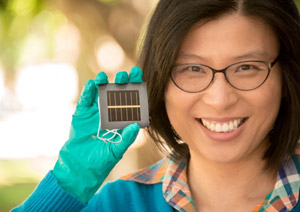- News
5 December 2016
UNSW achieves record efficiency for perovskite solar cells
At the 2016 Asia-Pacific Solar Research Conference at the Australian National University, Canberra (29 November – 1 December), Anita Ho-Baillie, a senior research fellow at the Australian Centre for Advanced Photovoltaics (ACAP), announced that her team at the University of New South Wales (UNSW) has achieved the record efficiency with the largest perovskite solar cells to date.
The 12.1% efficiency was for a 16cm2 perovskite solar cell, the largest single perovskite photovoltaic cell certified with the highest energy conversion efficiency, and was independently confirmed by the international testing centre Newport Corp in Bozeman, Montana. The new cell is at least 10 times bigger than the existing certified record-efficiency perovskite solar cells, it is reckoned.
Ho-Baillie's team has also achieved 18% efficiency on a 1.2cm2 single perovskite cell, and 11.5% for a 16cm2 four-cell perovskite mini-module, both independently certified by Newport.
 Picture: Dr Anita Ho-Baillie with perovskite cell.
Picture: Dr Anita Ho-Baillie with perovskite cell.
"This is a very hot area of research, with many teams competing to advance photovoltaic design," says Ho-Baillie. "Perovskites came out of nowhere in 2009, with an efficiency rating of 3.8%, and have since grown in leaps and bounds," she adds. "These results place UNSW among the best groups in the world producing high-performance perovskite solar cells. And I think we can get to 24% within a year or so."
Perovskite is a structured compound, where a hybrid organic-inorganic lead or tin halide-based material acts as the light-harvesting active layer. They represent the fastest-advancing solar technology to date, and are attractive because the compound is cheap to produce and simple to manufacture, and can even be sprayed onto surfaces.
"The versatility of solution deposition of perovskite makes it possible to spray-coat, print or paint on solar cells," notes Ho-Baillie. "The diversity of chemical compositions also allows cells to be transparent, or made of different colours. Imagine being able to cover every surface of buildings, devices and cars with solar cells."
Most of the world's commercial solar cells are made from refined, highly purified silicon crystal and, like the most efficient commercial silicon cells (PERC cells, invented at UNSW), they need to be baked above 800˚C in multiple high-temperature nature steps. Perovskites, on the other hand, are made at low temperatures and are 200 times thinner than silicon cells.
But although perovskites hold much promise for cost-effective solar energy, they are currently prone to fluctuating temperatures and moisture, making them last only a few months without protection. Along with every other team in the world, Ho-Baillie's is trying to extend the durability. Due to what engineers learned from more than 40 years of work with layered silicon, they are are confident that they can extend this.
Nevertheless, there are many existing applications where even disposable low-cost, high-efficiency solar cells could be attractive, such as use in disaster response, device charging and lighting in electricity-poor regions of the world. Perovskite solar cells also have the highest power-to-weight ratio among viabale photovoltaic technologies, it is reckoned.
"We will capitalize on the advantages of perovskites and continue to tackle issues important for commercialization, like scaling to larger areas and improving cell durability," says Ho-Baillie's mentor, ACAP director Martin Green. The project's goal is to increase perovskite solar cell efficiency to 26%.
The research is part of a collaboration backed by $3.6m in funding through the Australian Renewable Energy Agency's (ARENA) 'solar excellence' initiative. ARENA's CEO Ivor Frischknecht says that the achievement demonstrated the importance of supporting early-stage renewable energy technologies: "In the future, this world-leading R&D could deliver efficiency wins for households and businesses through rooftop solar as well as for big solar projects like those being advanced through ARENA's investment in large-scale solar."
Ho-Baillie, who obtained her PhD at UNSW in 2004, is a former chief engineer for Solar Sailor, an Australian company that integrates solar cells into purpose-designed commercial marine ferries which currently ply waterways in Sydney, Shanghai and Hong Kong.
ACAP is a national research collaboration based at UNSW, whose partners are the University of Queensland, Monash University, the Australian National University, the University of Melbourne and the CSIRO Manufacturing Flagship. The collaboration is funded by an annual grant from ARENA, and partners include Arizona State University, Suntech Power and Trina Solar.


